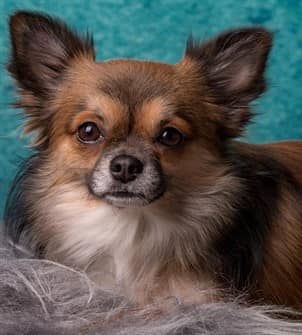Chihuahua Shedding
Overview
Many owners and potential owners have questions regarding Chihuahua shedding. Does this tiny toy breed shed? And if so, how much shedding is normal? This page will answer your questions about shedding, for both short hair and long hair Chihuahuas. We are going to look at:
- How much shedding is considered to be normal
- Problems - including excessive shedding
- When to expect shedding - seasonal shedding and summer time
- Steps that you can take to control shedding
- Grooming tools and Chihuahua shedding brushes that are good for the coat
Please note:
PetChiDog is reader-supported. Some of the product suggestions on this page are affiliate links. As an Amazon Associate we earn from qualifying purchases. This is at no extra cost to you and helps keep this site running.
Normal, Expected Shedding with the Chihuahua Breed
Chihuahuas do shed, and new owners may be surprised to learn that even short haired Chihuahuas are considered moderate shedders.
Some Chihuahuas have single coat of fur and some have a double coat, although this does not necessarily affect the amount of shedding for any particular dog. It should be noted that it is a common misconception that all long coats have double coats and short haired Chi's have single coats. Either variety may have a single or double coat.
Some say that long coats shed less than short haired Chihuahuas. This also is not true. Each Chi will shed differently and at varying amounts throughout the year.
For both long and short coated Chihuahua dogs, the hairs of the coat have a growth cycle. Each hair follicle has a stage of : Growth (anagen), rest (catagen), and falling out (telogen). As individual hairs are falling out (telogen) others are growing in. This is the shedding process.
Shedding with Puppies
Puppies will go through a process in which the soft and fine puppy hairs are replaced with a slightly thicker and courser adult coat. For some pups, this changeover can take place in a relatively short amount of time causing quite a heavy shed. For others, the change is more gradual.
In either case, during the first year you can expect for there to be a good amount of shedding and also a possible color change as that adult coat comes in. What type of changes will occur? Solids can become partis, thin patches of a secondary color can come in stronger, or a coat may lighten or darken.
It will be important to regularly groom
your Chihuahua puppy during this shedding process, as removing dead hairs to make room for new growth is vital for good skin and coat health. We will talk more about this ahead.
Seasonal and Summer Shedding
There are going to be times when a Chihuahuas sheds more than normal and these will be periods of moderate to heavy shedding. This typically occurs in response to a change in the seasons.
Many people mistakenly believe that when temperatures drop or rise that it triggers falls out or growth; however, it is the sunlight variations that trigger fluxes in a dog's pineal gland that in turn trigger the coat to shed.
In some areas of the country, there can be a dramatic difference in sunlight hours ; as little as 9 in the winter VS as many as 15.5 in the summer, even if temperatures remain even.
Therefore, twice a year - late fall and early spring - as days become shorter and then as days become longer, you can expect to see a change in shedding and this will vary depending on where you live.
It is the spring/ summer shed that is often heavier than the fall shed.
Other Reasons for Shedding - Extreme Thinning of the Coat
An overall moderate to severe thinning of the coat that leads to patchy areas of extremely thinned fur or even bald spots is referred to alopecia. While there are various causes for this (allergies, thyroid, Cushing's disease), many times the cause is 'unknown' (referred to as alopecia X).
In regard to allergies, there are often other symptoms including itchy skin, rash, and/or hot spots. It is usually poor skin health that then lead to fur loss over affected areas.
Alopecia X
It is vital to not make this diagnosis yourself. The veterinarian will run tests to rule out common cause of fur loss.
In the event of an alopecia X diagnosis, there are some treatments that can help:
1.
There is some evidence that this is linked with hormonal changes; for this reason, spaying or neutering a dog can bring about improvement. In some cases, it is temporary, in others it is permanent.
2. For approximately 50% of dogs with severe fur loss due to alopecia X, melatonin (a naturally occurring produced at night by the pineal gland, which helps regulate the wake/sleep cycle) prompts regrowth of fur.
You will want to check with your vet before giving this, because it can cause drowsiness, can interfere with certain medicatoins, and should not be given to dogs with certain health conditions.
Typical dosing is 1 mg for a 10 lb. dog and 1/2 mg for a 5 lb. dog, two to three times per day for 3 months. You'll find that it's easiest to offer the right dose when tablets are just 1 mg, as with Nature's Bounty Melatonin 1 mg Tablets . Note that fur may start growing back in after 6 to 8 weeks, but this dosing should be continued as long as their are no worrisome side effects.
. Note that fur may start growing back in after 6 to 8 weeks, but this dosing should be continued as long as their are no worrisome side effects.
Once those 3 months are complete, this is usually tapered down until a dog is on a maintenance dose of just once per week.
3.
Restorative lotions and shampoos can help stop excessive shedding and prompt fur growth. The act of massaging the skin helps to circulate blood flow to the follicles. And, healing ingredients such as aloe vera, shea butter, and tea tree oil can improve skin health.
A fantastic restorative lotion is ResQ Organics Pet Skin Treatment ; this is 100% organic and has a slew of healing ingredients including aloe vera, Manuka honey, coconut, olive oil, shea butter, and hemp seed oils.
; this is 100% organic and has a slew of healing ingredients including aloe vera, Manuka honey, coconut, olive oil, shea butter, and hemp seed oils.
And a great bathing product for fur loss is DERMagic Peppermint & Tea Tree Oil Shampoo & Conditioner .
.
4.
The final piece of the puzzle is an omega 3 fish oil supplement. This essential oil is well-known for boosting skin and coat health. While top quality dog foods will contain this, with severe shedding to the point of bald spots, an added boost of omega can help.
We recommend Pure Wild Alaskan Salmon Oil for Dogs , which is a liquid supplement; just one-half to one pump per day, added to a meal, is all that is needed.
, which is a liquid supplement; just one-half to one pump per day, added to a meal, is all that is needed.
Female Shedding
An unspayed female Chihuahua may have a moderate to heavy shed that is triggered by the
heat cycle. This usually occurs at the end of the cycle and this is due to hormonal changes.
In addition, it is common for dams to have excessive shedding after giving birth; again to due hormonal changes.
Steps That You Can Take to Control Shedding
There are many things that you can do to help with shedding problems and keep things under control:
1- Brush often & with the right brush or tool.
The more dead hairs you can pull out by brushing, the more expedited the shedding cycle will be. In addition, if shedded hairs are not removed, they can accumulate and eventually cut off proper air circulation to the skin. This can create many problems. Of top concern, is that a layer of dead hairs blocking air flow and creating a moist environment can lead to a fungus or yeast infection of the skin.
The Best Brushes for Chihuahuas
- For year round proper grooming, choose a quality bristle brush if you have a smooth coat Chihuahua. One like the Safari Bristle Brush
 is ideal.
is ideal.
And choose a two-sided bristle/pin brush for a longcoat Chihuahua, using the pin brush for longer hairs, and the bristle side for shorter areas. The Double Sided Grooming Tool Pin & Bristle Brush by Furrep
 is sized nicely, has quality coated pin tips, and even comes with a free comb.
is sized nicely, has quality coated pin tips, and even comes with a free comb.
For times of moderate to heavy shedding you may not want to technically use a brush, as a de-shedding glove can work much better. One like the Delomo Pet Grooming Glove
 is perfect for Chihuahuas that are shedding but do not have any tolerance for sitting long enough to be brushed all over their body.
is perfect for Chihuahuas that are shedding but do not have any tolerance for sitting long enough to be brushed all over their body.
This is a stretchy glove that you slip over your hand; most dogs are receptive to being petted with this, and it's very effective for pulling out dead hairs.
How to Brush
- The key is to not just skim over the top layer of fur. You will want to gently brush down through the coat, down to the skin, and then sweep up and out. Work section by section and stop to remove hairs from the brush or glove as they accumulate.
How Often
- For normal upkeep, it is recommended to give the coat a good brushing once a week. However, during heavy shed times (seasonal spring/summer shed & after heat cycles) 2 to 3 times per week may be necessary to keep up with the shedding hairs.
It is recommended to choose a certain time of the day for this; canines have amazing internal time clocks and if an owner grooms their Chihuahua at a certain time each day, the puppy or dog often learns to relax while being brushed, knowing that it is time to do so.
2 - Food plays a role in both skin and coat health. Chemical preservatives, colorings, artificial flavorings, high corn levels, soy, wheat, and fillers found in many manufactured foods can wreak havoc on both skin and coat. You may wish to read more in the Chihuahua feeding
section.
3 - Supplements may be needed for some dogs. For Chihuahuas with dry skin problems and excessive shedding, adding an Omega 3 fish oil supplement can help to keep the skin healthy and often can reduce fall-out.
4. Timing of baths.
It is important to find the right balance in giving a Chihuahua baths. Too many can dry out the skin which can lead to more shedding. Too few can be just as bad. It is best to schedule baths just about every 3 weeks. If your dog is shedding excessively, brush through the coat both before and after bath time.
5- Routine Cleanup.
Cleaning both floors and furniture on a regular basis will help with the effects of fallen hairs. Even a small amount of fur on a sofa can stick to your clothes and then be transported throughout the house.
You may have noticed that shedded hairs have notoriously wound their way into fabrics and are horrendously hard to pull out. Often, a regular vacuum won't suction them out.
So, your Chihuahua may be leaving behind hairs in your carpeting and/or sofa that are seemingly going to be there forever.
There are some hand-held vacuums specifically designed to pull out pet hairs like the Bissell Pet Hair Eraser Handheld Vacuum . This works great for spot cleaning, doing steps, beds, etc.
. This works great for spot cleaning, doing steps, beds, etc.
And if you want to keep it simple and super-affordable, there's a neat little, non-electric tool called the ChomChom Roller
 which works amazingly well.
which works amazingly well.






